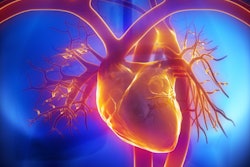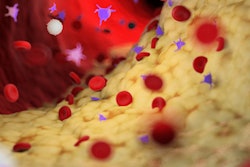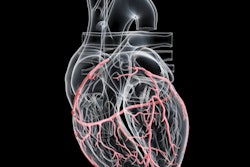
CT angiography (CTA) shows that statin treatment in patients at risk of heart disease not only reduces the volume of some types of coronary plaque -- thus slowing progression toward more advanced disease -- it also changes plaque density, according to a study published on 18 August in JAMA Cardiology.
The results further demonstrate how characterizing plaque density is useful for assessing atherosclerotic disease risk, wrote a team led by Dr. Alexander van Rosendael of Leiden University Medical Center in the Netherlands.
"[Our] results suggest an association of statin use with greater rates of transformation of coronary atherosclerosis toward higher-density calcium," the group noted.
High plaque volumes are associated with higher future risk of heart disease, but the density of the plaque can mitigate this risk, with "higher-density calcium ... associated with lower major event risk," the study authors wrote. Calcium in the cardiac arteries is typically assessed by its type and its density is not necessarily considered. But perhaps it should be, according to van Rosendael's team.
"Low-density calcium may not portend the same low-risk status as higher-density calcium, such as 1K plaque," the group wrote.
The researchers hypothesized that alterations in plaque over time could offer a more detailed understanding of the progression of atherosclerotic disease.
To investigate further, the researchers conducted a study that included 857 patients who underwent multiple CTA exams two or more years apart between 2013 and 2016. They categorized plaque into the following six types according to attenuation (expressed in Hounsfield units [HU]):
- Low attenuation (-30 to 75 HU)
- Fibro-fatty (76 HU to 130 HU)
- Fibrous (131 HU to 350 HU)
- Low-density calcium (351 HU to 700 HU)
- High-density calcium (701 HU to 1,000 HU)
- 1K (> 1,000 HU)
The team evaluated plaque progression rates of these six types by assessing the interaction between statin use and baseline plaque volume (adjusting for patient risk factors such as age, sex, diabetes, hypertension, smoking status, and body mass index, as well as time between CTA scans).
A total of 2,458 coronary lesions were found in the patient cohort, and the plaque volume of untreated lesions increased over the study timeframe for all six types of plaque. But statin therapy helped, showing statistically significant decreases in the volume of some plaque types -- specifically low-attenuation plaque and fibro-fatty plaque -- and increases in high-density calcium volume and 1K plaque volume. (The group measured this effect using the beta coefficient, where value decreases show stronger positive intervention effect than increases.)
| Effect of statin therapy on coronary plaque as assessed on CTA, measured by the beta coefficient | |||
| Type of plaque | Plaque volume at baseline CTA (mm3) | Plaque volume on follow-up CTA after statin therapy | p-value |
| Low-attenuation plaque | 0.003 | -0.02 | 0.001 |
| Fibro-fatty plaque | 0.014 | -0.03 | < 0.001 |
| Fibrous plaque | 0.01 | -0.01 | 0.58 |
| Low-density calcium | 0.10 | -0.01 | 0.11 |
| High-density calcium | 0.04 | 0.02 | < 0.001 |
| 1K plaque | 0.025 | 0.02 | < 0.001 |
The study results show that statin therapy slows the advancement of heart disease, according to the group.
"These findings appear to be associated with a seesaw effect, whereby plaque transforms toward higher-density calcification," Rosendael and colleagues concluded. "Specifically, statin therapy was not associated with overall calcified plaque progression but with a transformation toward denser calcium."



















